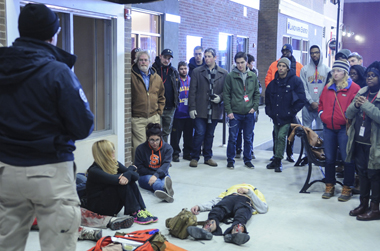Simulation Course Creates Strong Impressions, Enriches Understanding
 |
|
CEHC students and Interim Dean David Rousseau (leaning on wall) observe a simulation of a coordinated and complex terrorist attack at the State Preparedness Training Center "Cityscape." Training role players portray fallen victims, and EMS and FDNY Lieutenant Carlos Lopez (back to us) explains the details of the scenario and response. |
ALBANY, N.Y. (March 25, 2016) — When the College of Emergency Preparedness, Homeland Security and Cybersecurity (CEHC) blended theory with practice for students over this Winter Session in its new “Simulation: Building Security and Preparedness” course, it expected the 19 students enrolled to find the exercise in experiential learning rewarding.
“It turned out to be received even more positively than we imagined,” said Elizabeth Gray, assistant dean in the college. “Several of the students described it as a truly transformative experience.”
The course focused on two distinct but related areas: emergency incident command and control, and emergency operations center activities in times of disaster or catastrophic event. Students began the course with a foundation of learning activities including primary source readings and discussion blended with a modified table-top exercise.
The students then transitioned to the New York State Preparedness Training Center located in Oriskany, 10 miles west of Utica. Here, they engaged with and observed high-end scenario-based simulations involving the emergency response, command and control of law enforcement, EMS, and fire service agencies to several “incidents,” each focusing on different challenges.
Day two of this phase moved to county emergency operations center activities, where the class engaged in a simulation involving a level 6.2 earthquake. The simulations were orchestrated by faculty and experienced subject matter experts. Phase 3 took place at the New York State Emergency Operations Center, where the class learned about state-level EOC operations, followed by a short simulation involving a state’s response to a 6.2 level earthquake.
The course culminated with a week in which each student reflected upon his/her experience and drafted a capstone essay summarizing the lessons learned from the simulation.
Most commented that the experience opened their eyes to new career possibilities and enhanced their professional futures. As one student described it, “I believe this experience has impacted my future professional ability to engage in the homeland security enterprise because I had an inside look into careers I didn’t know existed.”
The course is now part of the CEHC minor, and in the major, now under review, such experiential courses and other applied learning opportunities will be integral. During the 2016 Summer Session, the simulation course will again be offered, this time with a focus on counter-terrorism.
![]() For more news, subscribe to UAlbany's RSS headline feeds
For more news, subscribe to UAlbany's RSS headline feeds
A comprehensive public research university, the University at Albany-SUNY offers more than 120 undergraduate majors and minors and 125 master's, doctoral and graduate certificate programs. UAlbany is a leader among all New York State colleges and universities in such diverse fields as atmospheric and environmental sciences, business, education, public health,health sciences, criminal justice, emergency preparedness, engineering and applied sciences, informatics, public administration, social welfare and sociology, taught by an extensive roster of faculty experts. It also offers expanded academic and research opportunities for students through an affiliation with Albany Law School. With a curriculum enhanced by 600 study-abroad opportunities, UAlbany launches great careers.


